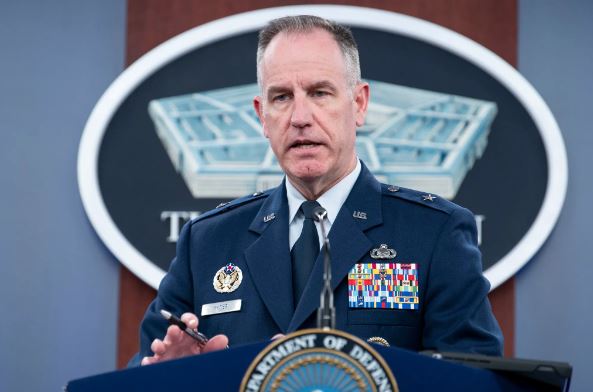In a retaliatory move, the United States conducted two airstrikes on facilities in eastern Syria that were being used by Iran’s Islamic Revolutionary Guards Corps (IRGC) and its affiliated proxy groups. The operation was prompted by a series of recent rocket and drone attacks against American forces in Iraq and Syria. These precision strikes, carried out by Air Force F-16 jets, were intended to send a clear message to Iran to rein in the attacks, which the Biden administration has attributed to Tehran’s proxies operating in Syria and Iraq. It is worth noting that the targets in this attack included facilities used by Iran’s own forces in the region, rather than just the militias in Iraq and Syria that Iran supports with weapons, training, and equipment.
The strikes occurred at a sensitive time, as they coincided with efforts by President Biden and his administration to contain the ongoing conflict between Israel and Hamas, aiming to prevent it from escalating into a regional conflict that would involve Iran and its proxies in Lebanon, Syria, and Iraq. In response to the growing tensions in the Middle East, the United States has taken proactive measures, such as deploying two aircraft carriers to the eastern Mediterranean near Israel and increasing the presence of warplanes in the Persian Gulf region. These actions are part of a broader strategy to deter Iran and its proxies from engaging in a regional war. The Pentagon has also expedited the deployment of additional Patriot antimissile batteries and other air defense systems to several Gulf nations in order to protect U.S. troops and bases in the region.
The recent increase in attacks against U.S. forces in the past ten days—reportedly totaling at least 19 incidents according to the Pentagon—had created growing pressure on the United States to respond militarily. Defense Secretary Lloyd J. Austin III issued a statement emphasizing that these targeted strikes were carefully designed to protect and defend U.S. personnel in Iraq and Syria. He clarified that these actions were distinct from the ongoing conflict between Israel and Hamas and did not represent a change in the U.S. approach to that conflict. His statement underscored the U.S. administration’s commitment to avoiding further hostilities, and its intention to deter Iranian-backed attacks against U.S. forces in the region.
However, the U.S. strikes did not involve coordination with Israel’s military, as emphasized by Pentagon officials. They provided few specific details about the extent of damage caused by the airstrikes and what type of response might be expected from Iran and its allies. According to the Pentagon, two Air Force F-16 strike aircraft, based in the region, targeted a weapons storage facility and an ammunition storage facility near Abu Kamal, Syria. While the site had not been used to launch rockets or drones, it was confirmed that munitions stored there had been used in recent attacks against U.S. forces. The presence of individuals at the site on the day of the strikes was confirmed, but it remained unclear whether any Iranian or militia personnel were injured or killed.
In line with previous U.S. actions, these airstrikes targeted Iran-backed facilities in eastern Syria, rather than southern Iraq, where these groups operate with greater latitude. The U.S. government has urged Iraqi officials to take stricter measures against these groups in the southern region, but these efforts have yielded little success. It is important to note that conducting American airstrikes could have a destabilizing effect on the Iraqi government, which collaborates closely with the U.S. government.
The strikes carried a clear message from the U.S. government, as Mick Mulroy, a former defense official and retired C.I.A. officer, articulated: “We will directly respond against Iran, and specifically the I.R.G.C., if they continue to attack our military positions and personnel in Iraq and Syria.” President Biden had previously issued a warning to Iran regarding continued attacks on U.S. military personnel in the region.
The airstrikes were executed early in the morning, just hours after the Pentagon disclosed that 19 U.S. military personnel based in Iraq and Syria had sustained traumatic brain injuries following rocket and drone attacks from Iran-backed militants the previous week. Initially, the Defense Department had reported that 21 service members had suffered minor injuries but had returned to their duties after the attacks on October 17 and 18. However, Brig. Gen. Patrick S. Ryder, the Pentagon spokesman, revealed that 15 of the 17 service members injured at al-Tanf and all four of the troops injured at Al Asad had subsequently been diagnosed with traumatic brain injuries.
The United States currently has 2,500 troops in Iraq and 900 in Syria, primarily focused on supporting local allies in counterterrorism missions against the Islamic State. These airstrikes are consistent with the U.S. response to previous attacks by Iranian-linked groups against U.S. forces in Iraq and Syria. The Biden administration has emphasized its commitment to self-defense and its readiness to respond to threats, asserting that it reserves the right to take further measures if attacks by Iran’s proxies against U.S. forces continue. While it seeks to avoid a broader conflict in the region, the United States remains prepared to protect its personnel and interests.

